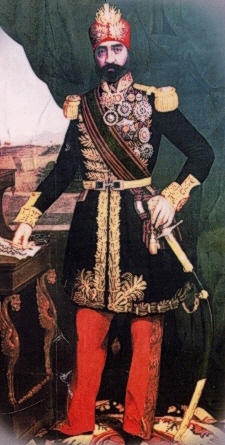
Tunis is the capital and largest city of Tunisia. The greater metropolitan area of Tunis, often referred to as "Grand Tunis", has about 2,700,000 inhabitants. As of 2020, it is the third-largest city in the Maghreb region and the eleventh-largest in the Arab world.

Muhammad III as-Sadiq commonly known as Sadok Bey, was the Husainid Bey of Tunis from 1859 until his death. Invested as Bey al-Mahalla on 10 June 1855, he succeeded his brother Muhammad II ibn al-Husayn on 23 September 1859. Named as divisional General in the Imperial Ottoman Army on 10 June 1855, he was promoted to the rank of Marshal on 10 December 1859.

The Regency of Algiers or State of Algiers was first an autonomous, then later a sovereign stratocratic Eyalet of the Ottoman Empire in North Africa from 1516 to 1830. It was founded by the corsair brothers Oruç and Hayreddin Barbarossa. Situated between the regency of Tunis in the east, the Sherifien Sultanate of Morocco and Spanish Oran in the west, the Regency originally extended its borders from the Mellegue river in the east to Moulouya river in the west and from Collo to Ouargla, and had nominal authority over the Tuat as well as the country south of In Salah in the south. Towards the end of the Regency, it extended to the present eastern and western borders of Algeria.

A consul is an official representative of a government who resides in a foreign country to assist and protect citizens of the consul's country, and to promote and facilitate commercial and diplomatic relations between the two countries.

The Acropolium, also known as Saint Louis Cathedral, is a former Roman Catholic church located in Carthage, Tunisia.

The Beylik of Tunis, also known as Kingdom of Tunis was a largely autonomous beylik of the Ottoman Empire located in present-day Tunisia. It was ruled by the Husainid dynasty from 1705 until the establishment of the French protectorate of Tunisia in 1881. The term beylik refers to the monarch, who was called the Bey of Tunis. Under the protectorate, the institution of the Beylik was retained nominally, with the Husainids remaining as largely symbolic sovereigns.

The French conquest of Tunisia occurred in two phases in 1881: the first consisting of the invasion and securing of the country before the signing of a treaty of protection, and the second consisting of the suppression of a rebellion. The French protectorate of Tunisia that was established lasted until the independence of Tunisia on 20 March 1956.

Italian Tunisians are Tunisian-born citizens who are fully or partially of Italian descent, whose ancestors were Italians who emigrated to Tunisia during the Italian diaspora, or Italian-born people in Tunisia. Migration and colonization, particularly during the 19th century, led to significant numbers of Italians settling in Tunisia.

The Embassy of the United Kingdom in Moscow is the chief diplomatic mission of the United Kingdom in the Russian Federation. It is located in the Arbat District of Moscow, on Smolenskaya Embarkment of the river Moskva. The current ambassador is Deborah Bronnert CMG.

Foreign relations exist between Australia and Germany. Both nations are members of the G-20 major economies, Organisation for Economic Co-operation and Development and the United Nations.

France–Morocco relations are bilateral relations between Morocco and France. They are part of the France–Africa relations.

Avenue Habib Bourguiba is the central thoroughfare of Tunis, and the historical political and economic heart of Tunisia. It is named for Habib Bourguiba, the first President of Tunisia and the national leader of the Tunisian independence movement. Today, the broad Avenue aligned in an east-west direction, lined with trees and facades of shops, and fronted with street cafes on both sides, and which is compared to the Champs-Élysées in Paris, and its extension, the Avenue de France, Place de l'Indépendance marking the central roundabout with Lake of Tunis at the eastern end. Many of the important monuments are located along this avenue, including Cathedral of St. Vincent de Paul, French Embassy in Tunisia and Théâtre municipal de Tunis.

The Embassy of the United Kingdom in Bangkok is the chief diplomatic mission of the United Kingdom in Thailand. Established as an embassy in 1947, its history dates to 1856 when a British consul was first posted in Bangkok following the signing of the Bowring Treaty. First established on Charoen Krung Road by the Chao Phraya River, the mission relocated to a new site on the corner of Phloen Chit and Witthayu Roads in 1922. Originally a rural location on the outskirts of the city, the area soon developed into one of the city centre's prime locations. The compound remained a leafy oasis amidst its densely developed surroundings throughout the 20th century, but was sold to Central Group at record-setting prices, first partially in 2007, then completely in 2017. The embassy is now based in an office building on Sathon Road, while its original buildings, including the ambassador's residence, have been demolished to make way for redevelopment.

Libyan–Tunisian relations are longstanding between the two neighbouring North African Maghreb states, Libya and Tunisia.

Until 1815 the Beylik of Tunis maintained a corsair navy to attack European shipping, raid coastal towns on the northern shores of the Mediterranean and defend against incursions from Algiers or Tripoli. After 1815 Tunis tried, with limited success, to create a modern navy, which fought in the Greek War of Independence and the Crimean War.

}}

Edith Stedham was a English housekeeper and businessperson in Tunis. She was the first British woman to live there and her daughter was the first British woman born in Tunis,


















